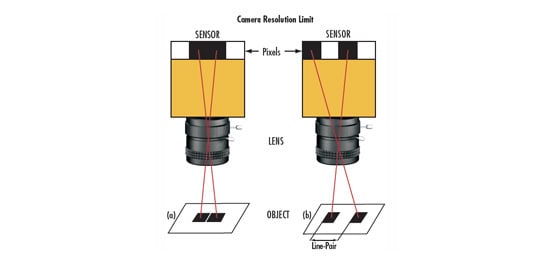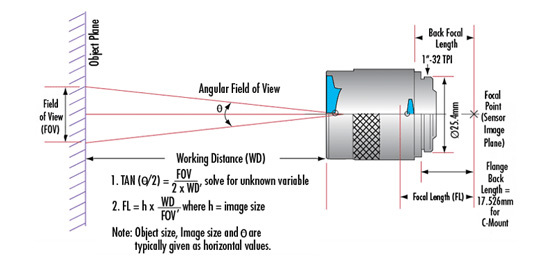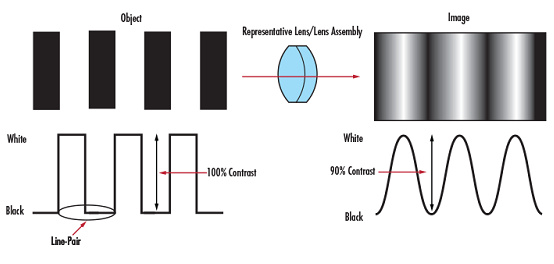The Modulation Transfer Function (MTF)
Authors: Gregory Hollows, Nicholas James
This is Section 2.5 of the Imaging Resource Guide.
Understanding and calculating a lens's performance can be difficult. There are many variables that affect lens performance, including diffraction, optical aberrations, design criteria and philosophy, and manufacturing tolerances and errors. To obtain optimal system performance, both optical designers and end-users must have access to the metrics used to display measured lens performance; this measured lens performance is provided in the form of modulation transfer function (MTF) curves.
Modulation Transfer Function (MTF)
The modulation transfer function (MTF) curve is an information-dense metric that reflects how a lens reproduces contrast as a function of spatial frequency (resolution). These curves offer a composite view of how optical aberrations affect performance at a set of fundamental parameters set by application need. Understand that changing any setting on a vision system, including fundamental parameters, will change the characteristics of the curve. Fundamental lens and imaging parameters are defined in Imaging Fundamentals.
Figure 1 shows a common type of MTF curve, which describes the modulus of the optical transfer function (contrast) vs. frequency (resolution). How frequency is determined is covered in Resolution. This curve provides a broad overview of a lens's performance at a specific working distance (WD), f/#, sensor size, and wavelength range. Because MTF curves show resolution and contrast information simultaneously, multiple lenses can be evaluated based on application requirements and compared to one another. If used correctly, MTF curves can be used to determine if an application is feasible.

Figure 1: An MTF performance curve illustrates contrast vs. frequency.
While there are several ways to display MTF (e.g. MTF v frequency, MTF vs field), a common way of expressing it for MTF v frequency is with multiple colored curves (black, blue, green, and red). The solid black line at the top is the diffraction limit of the lens and represents the absolute limit of lens performance. No matter how advanced the lens performance, it cannot be modified to rise above this line. The additional colored lines on the curve below the diffraction limit represent the actual MTF performance of the lens. They correspond to different field heights (positions across the sensor). In this case, there are three different field heights represented: on-axis (blue), which represents the center of the image circle; 70% of the diameter of the image circle (green), which represents about half the image area; and the full image circle (red), which is the corner of the image sensor that is in use. Note that some curves will contain more field points for analysis.
The other noteworthy feature on the curves is the difference between solid and dashed lines, represented on the curve by the letters T and S, which represent the tangential (T: yz) and sagittal, or “radial” (S: xz) planes of focus, respectively. These fields are different due to aberrations that are caused by asymmetry, such as astigmatism, which is why there is not separate tangential and sagittal on-axis curves. This variation causes field spots to blend together more quickly in one direction than the other and produces different contrast levels on different axes at the same frequency. It is important to consider the implications of the lower of these two lines when evaluating a lens for a given application. It is generally advantageous to maximize the contrast level across the entire sensor to gain the highest levels of performance in a system. If element tilts or decenters exist, as they do in manufactured lenses, the asymmetry would cause there to be different T and S curves on-axis as well, though this is never illustrated in MTF curves. For more information on MTF curves see the app note Introduction to Modulation Transfer Function.













 Previous Section
Previous Section 
















or view regional numbers
QUOTE TOOL
enter stock numbers to begin
Copyright 2023, Edmund Optics India Private Limited, #267, Greystone Building, Second Floor, 6th Cross Rd, Binnamangala, Stage 1, Indiranagar, Bengaluru, Karnataka, India 560038
California Consumer Privacy Acts (CCPA): Do Not Sell or Share My Personal Information
California Transparency in Supply Chains Act
The FUTURE Depends On Optics®